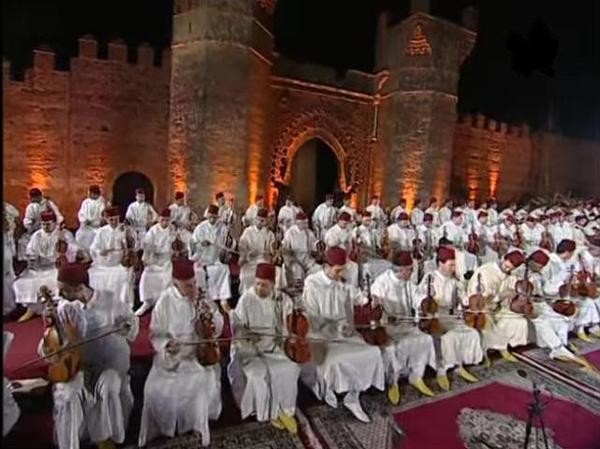The creation of Andalusian music as practiced in modern Moroccan music is today contributed almost completely to one man, Ali ibn Nafi, often called Ziryab. His arrival in Cordoba in 822 sparked a wave of musical revolution in Al-Andalus, which led to the creation of modern Andalusian music. Ziryab had studied in Baghdad, but according to legend was forced to leave the city after his teacher became jealous of his prodigious ability. Ziryab became a musician in the Umayyad court, at the center of Al-Andalus, and soon his style of singing supplanted that of the other court musicians.
"The early Andalusians sang in the Christian style, until the arrival of the grand master Ali Ibn Nafi, nicknammed Ziriab... He showed them songs they had never heard before. His style of singing was soon imitated, to the exclusion of all other styles." - Ahmad at-Tifachi: Mout'at al-asma'
Ziryab's style combined the traditions he learned in Baghdad with his own inventions to create what is today known as Andalusian music. Ziryab's innovations included adding a fifth string to the lute to expand its range and creating strings out of lion-cub intestines. Ziryab also created a conservatory in Cordoba, facilitating the continuation his musical innovations.
Andalusian music spread to Morocco by the 10th century. With the rise of the Berber Almohad Caliphate in the 12th century, Andalusian music was suppressed, as the Almohads discouraged music as impious. Music in Morocco was confined to madihs(hymns honoring the Prophet Mohammed), but Andalusian music remained an influence on the madihs. This musical focus on piety continued more or less until the rise of the Alawite dynasty.
"Indeed, having escaped Ottoman rule, which its neighbors endured for more than three centuries, Morocco was able to preserve its musical heritage from the powerful influence of Turkish music. Morever, being geographically very far from the main artistic centers of the Orient, Morocco lived artistically self-reliant." - Younes Chami, Les Nawbas de la Musique Andalouse Marocaine, Vol. II, Translated from French
During the Alawite dynasty (beginning in 1631 and continuing today), Andalusian music resurged, and state sponsorship allowed for the emergence of new students of the genre. Schools founded in Fez and Marrakesh began to teach Andalusian music, and collections of Andalusian music were published for the first time. Nation-wide seminars were also held to discuss the preservation of Andalusian music.
"The sum effect of this being cast as a repertory that is merely to be preserved and passed on and all of the official overtones of Andalusian music–relating it to the upper class and royal family and its use in government occasions–has meant that for many young Moroccans, and particularly young Moroccan musicians, this is a repertory that’s not particularly appealing... if you’re a creative musician, you don’t choose to become an Andalusian specialist, because you can’t really add. You can become a master performer of this repertory, and it’s a beautiful repertory. I think all Moroccans see it somehow as part of Moroccan identity, but that doesn’t mean that they actually participate in it." - Dwight Reynolds
It is unclear how similar modern Moroccan Andalusian music is to the original style developed in Iberia. Over the years, 13 of the 24 original nubahs of which Andalusian music is composed have been lost, but the remaining nubahs seem to remain at least broadly faithful to the original Andalusian tradition.
"I started to practice this music more than fifty years ago, in an age when neither oriental music nor Western music had echoed in our artistic circles, and I can affirm that during this half-century, Andalusian music has not changed, despite the large transformations that have occurred in our country on every level." - Cheikh Ahmad Labzour Tazi, Professor of Andalusian music, Translated from French
Instruments of Andalusian Music
The primary focus of every Moroccan Andalusian musical ensemble is vocal; every member sings in addition to playing instruments. However, instruments play an important supporting role, and most pieces have significant instrumental sections. The instruments in an Andalusian ensemble can vary greatly from ensemble to ensemble, but below are several of the most common instruments found in an ensemble.
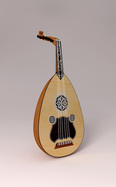
The oud is a five-stringed plucked instrument used in music throughout the Middle East. The oud used in Andalusian music is the Arab oud, which is tuned slightly lower than the Turkish oud. The western cousin of the oud is the lute.
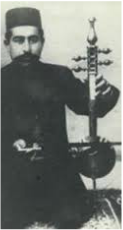
The traditional kamenjah is a bowed string instrument played throughout the middle east. It traditionally has three strings, but most modern kamanchehs have four. The kamancheh is less common in modern Andalusian ensembles, having been replaced by the violin in Morocco
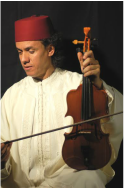
The modern kamenjah is a violin played on the knee, as shown in the picture. The violin was integrated into the ensemble around the 1850's, but has today almost completely replaced the original kamenjah, and is called by the same name. The violin is traditionally tuned to G, D, G'
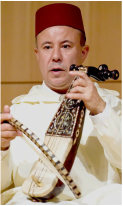
The rebab used in Moroccan Andalusian music differs greatly from other rebabs of North Africa and the Middle East; its body is much shorter. It is not to be confused with the rebab used in Berber music. It is a two stringed, bowed instrument.
|
|
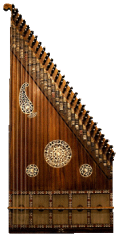
The qanun is a flat, 26-stringed instrument played throughout the Middle East. The strings are made out of nylon, gut, or metal-wound silk. The qanun is plucked with a pick made out of horn.
|
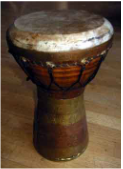
The darbouka, also called the doumbek, is a single-head drum. It is played held under the arm, or held sideways on the lap. Variations of this drum are found across North Africa and the Middle East.
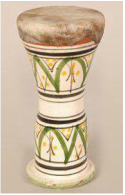
The taarija is a hand-held drum, made out of clay, with a goat-skin head. They can also occasionally be made out of metal.
Other western instruments now included in Andalusian orchestras include the piano and cello. Occasionally, other instruments such as the clarinet, saxophone, and flute, have been added in, although these instruments are more rarely used.
